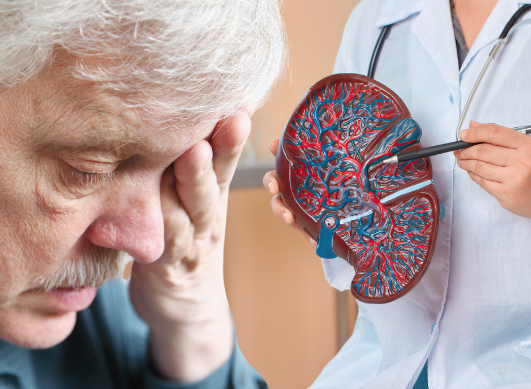NAFLD: everything there is to know about fatty liver disease
Published Jun 10, 2022 • By Candice Salomé
Non-alcoholic steatohepatitis is a chronic condition. It is estimated that about 6% of the U.S. adult population may be suffering from it.
This condition is a hepatic manifestation of a metabolic dysfunction and represents the most severe form of fatty liver disease, also known as non-alcoholic fatty liver disease (NAFLD).
So what is non-alcoholic fatty liver disease (NAFLD)? What is non-alcoholic steatohepatitis (NASH)? What are their causes and symptoms? How does one go from having NAFLD to having NASH? And what are the possible complications?
We explain it all in our article!

What is non-alcoholic fatty liver disease (NAFLD) and how does it progress?
NAFLD (non alcoholic fatty liver disease) is characterized by an abnormal accumulation of intrahepatic fat in the absence of excessive alcohol consumption.
Non-alcoholic fatty liver disease (NAFLD) affects 25% of the world population and has become the leading cause of chronic liver disease.
NAFLD covers a wide spectrum of liver lesions of which the two main ones are:
- isolated steatosis or steatosis accompanied by minimal lobular inflammation (NAFL for "non alcoholic fatty liver"). NAFL thus presents little or no damage to the liver. It does not usually progress to the point of causing liver complications, but it can provoke pain due to liver enlargement;
- non-alcoholic steatohepatitis (NASH). It is defined by the presence of steatosis with lobular inflammation and ballooning of the hepatocytes (cells that perform the main metabolic functions of the liver). NASH corresponds to the aggressive form of the disease, provoking the accumulation of fibrosis in the hepatic parenchyma, and leading to cirrhosis and its complications.
Steatosis (NAFL) occurs in individuals who constantly consume excess calories and lead a sedentary lifestyle, without significant alcohol consumption.
Thus, excess calories are stored in the liver cells as fat, resulting in a liver that contains more than 5% fat and has a pale yellow appearance.
NASH occurs when the accumulation of fat in the liver is too great. This leads to chronic inflammation and cell damage (called ballooning). At this stage of the disease, patients have a higher risk of death from cardiovascular disease.
Chronic and continuous ballooning and cell degradation lead to the accumulation of non-functional scar tissue (called fibrosis). This may eventually cause loss of liver function. This stage is called cirrhosis, or stage 4 fibrosis.
When patients reach the stage of NASH-related cirrhosis, they have a higher risk of end-stage liver disease. This may include: loss of liver function (decompensation), liver failure and liver cancer. These patients also have a higher risk of death from cardiovascular disease and cancer (all cancers).
What are the symptoms of NAFLD?
The majority of patients are asymptomatic. However, some patients may experience severe fatigue, dizzy spells or discomfort in the right upper quadrant.
Hepatomegaly (enlargement of the liver) is observed in about 75% of patients.
In addition, splenomegaly (abnormal enlargement of the spleen) may develop if advanced liver fibrosis is present. This is often the first sign of portal hypertension - an increase in the blood pressure within the portal vein. It is mainly due to the blockage in the liver, related to cirrhosis, which prevents the blood from passing through it.
In addition, patients with cirrhosis caused by NASH may also be asymptomatic. They may not show the usual signs of cirrhosis related to excessive alcohol consumption.
How is non-alcoholic steatohepatitis diagnosed?
NASH should be suspected in patients with a metabolic syndrome, such as obesity, type 2 diabetes, hypertension or dyslipidaemia (high lipid levels), as well as in patients with unexplained laboratory abnormalities that suggest hepatopathy (a generic term for liver disease without specifying the type of damage or the origin of the disease).
It can be difficult to differentiate simple steatosis from NASH. Elevated liver enzymes do not necessarily indicate NASH.
In addition, metabolic syndrome associated with elevated ferritin level increases the likelihood of a patient having NASH rather than simple steatosis.
In order to make a diagnosis, it is necessary to find strong evidence that alcohol consumption has not been excessive. This can be done by interviewing the patient's family and friends, for example.
Serological tests should also show the absence of infection with hepatitis B or C.
There are several complementary tests that allow to confirm (or not) the diagnosis of non-alcoholic fatty liver disease:
- Abdominal ultrasound: it shows the structure of the liver and allows to look for potential fibrosis,
- Liver biopsy: this is the only examination that can certify the diagnosis of NASH and assess its severity. It is only carried out when strictly necessary, as this procedure can lead to complications such as pain, hemorrhage or infection. The puncture specimens are subject to pathological analysis (microscopic analysis of cells or tissues removed from an organ).
The European Association for the Study of the Liver (EASL) recommendations suggest strict monitoring through non-invasive tests:
- Every 2-3 years for patients with NAFL without risk factors for disease progression,
- Every year for patients with NASH and/or fibrosis.
- Every 6 months for patients with NASH-related cirrhosis.
The search for new drugs is currently very active in the field of fatty liver disease. This is especially important since sedentary lifestyle has dramatically increased the number of NASH cases in the world.
Give it a "like" and share your thoughts and questions with the community in the comments below!
Take care!
Comments
You will also like

Fatty liver and family life: How to find the right balance when living with NAFLD and NASH?
Jun 3, 2025


 Facebook
Facebook Twitter
Twitter

